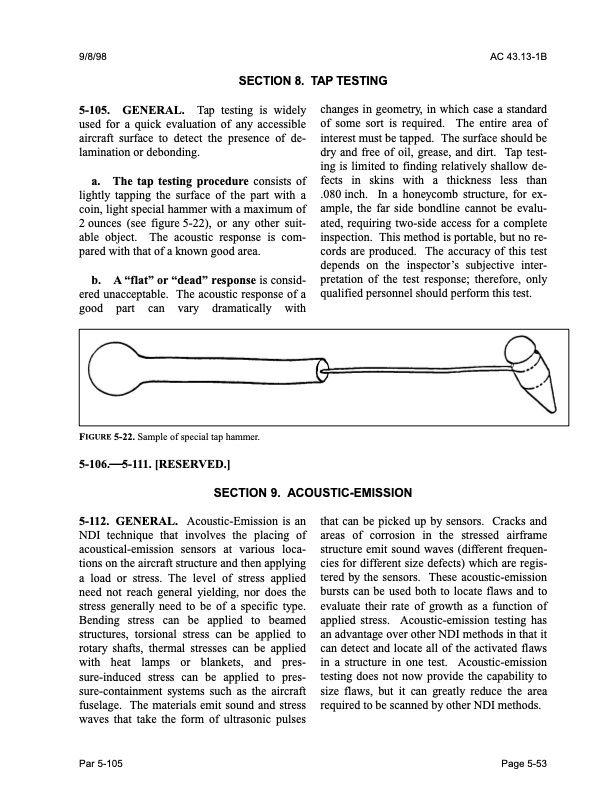
PDF Publication Title:
Text from PDF Page: 269
9/8/98 AC 43.13-1B 5-105. GENERAL. Tap testing is widely used for a quick evaluation of any accessible aircraft surface to detect the presence of de- lamination or debonding. a. The tap testing procedure consists of lightly tapping the surface of the part with a coin, light special hammer with a maximum of 2 ounces (see figure 5-22), or any other suit- able object. The acoustic response is com- pared with that of a known good area. b. A “flat” or “dead” response is consid- ered unacceptable. The acoustic response of a good part can vary dramatically with FIGURE 5-22. Sample of special tap hammer. 5-106.5-111. [RESERVED.] changes in geometry, in which case a standard of some sort is required. The entire area of interest must be tapped. The surface should be dry and free of oil, grease, and dirt. Tap test- ing is limited to finding relatively shallow de- fects in skins with a thickness less than .080 inch. In a honeycomb structure, for ex- ample, the far side bondline cannot be evalu- ated, requiring two-side access for a complete inspection. This method is portable, but no re- cords are produced. The accuracy of this test depends on the inspector’s subjective inter- pretation of the test response; therefore, only qualified personnel should perform this test. SECTION 8. TAP TESTING 5-112. GENERAL. Acoustic-Emission is an NDI technique that involves the placing of acoustical-emission sensors at various loca- tions on the aircraft structure and then applying a load or stress. The level of stress applied need not reach general yielding, nor does the stress generally need to be of a specific type. Bending stress can be applied to beamed structures, torsional stress can be applied to rotary shafts, thermal stresses can be applied with heat lamps or blankets, and pres- sure-induced stress can be applied to pres- sure-containment systems such as the aircraft fuselage. The materials emit sound and stress waves that take the form of ultrasonic pulses that can be picked up by sensors. Cracks and areas of corrosion in the stressed airframe structure emit sound waves (different frequen- cies for different size defects) which are regis- tered by the sensors. These acoustic-emission bursts can be used both to locate flaws and to evaluate their rate of growth as a function of applied stress. Acoustic-emission testing has an advantage over other NDI methods in that it can detect and locate all of the activated flaws in a structure in one test. Acoustic-emission testing does not now provide the capability to size flaws, but it can greatly reduce the area required to be scanned by other NDI methods. Par 5-105 Page 5-53 SECTION 9. ACOUSTIC-EMISSIONPDF Image | AFS-640

PDF Search Title:
AFS-640Original File Name Searched:
ac_43.13-1b_w-chg1.pdfDIY PDF Search: Google It | Yahoo | Bing
5,000 BF Shipping Container Lumber Dry Kiln For Quality Lumber The 5,000 BF container kiln consists of one 40 foot high-cube aluminum shipping container... More Info
Shipping Container Lumber Dry Kilns by Global Energy Global Energy designed and developed the container kiln back in 1991. The purpose is to give access to portable sawmill owners, furniture makers, and small business the value added profit of dry kiln lumber and quality hardwoods... More Info
Vacuum Kiln Conversion Kit for Lumber and Wood Dry Kilns Convert your existing conventional dry kiln into a fast drying vacuum kiln. Similar to vacuum bagging in the boat building and aircraft industry, we have come up with a proprietary process which allows you to build a very simple vacuum kiln at a fraction of the price, and without the intensive conventional metal chamber structure... More Info
Vacuum Pump Cart System for Bagging Clamping Wood Drying and more Vacuum Cart with 2HP Pump and Dual Pistons with multiple multiplex vacuum ports and liquid reservoir... More Info
Vacuum Bagging Basics Vacuum bagging is a method of clamping, which has traditionally been used in the composites industry, but can also be used for vacuum drying materials, including wood products... More Info
| CONTACT TEL: 608-238-6001 Email: greg@globalmicroturbine.com | RSS | AMP |